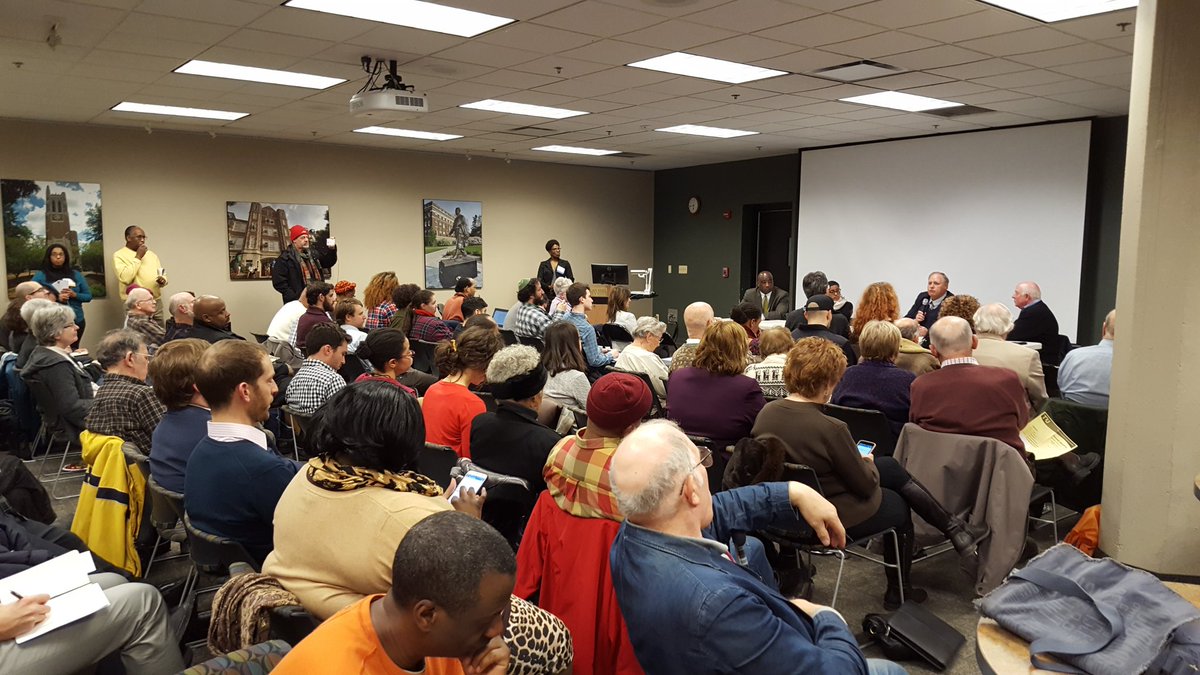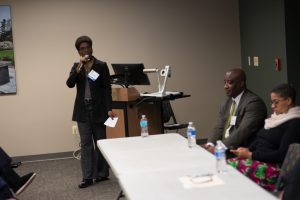
TRU’s Annual Meeting, held Monday January 2017 at the MSU Detroit Center, was packed with over 150 people including transit agency leaders and employees, bus riders, civic leaders, public officials, community activists, and transit supporters.
The event included:
- The 2016 Year In Review
- A State of Metro Detroit Transit Panel Discussion, featuring:
- RTA’s Michael Ford
- SMART’s John Hertel
- DDOT’s Dan Dirks
- M-1 Rail’s Sommer Woods
- The TRU Board Election
Highlights of the presentations are summarized below. The Detroit News also did a nice summary article. Full video of the panel discussion is available on Facebook.
2016 Year in Review from TRU

TRU’s Executive Director, Megan Owens, opened the meeting by stating that 2016 was a great year for transit in the 4-county region. It was a great year, because of the commitment and hard work of many people. Almost every person in attendance indicated they were involved last year in improving transit. Although the regional transit millage did not pass, 894,346 people voted yes, more than ever before. Review TRU’s Statement on the Regional Transit Millage Loss and TRU’s 2016 Detroit Transit Year-in-Review for more information. (video)
Admittedly, our transit problems still exist. People continue to struggle every day to get where they need to go despite the substantial work by the current transit providers. The providers are limited by geography and budget. The Southeast Michigan region spends a 1/3 of what comparable metro regions spend on public transportation per capita. There is no firm plan when regional transit funding will be placed back on the ballot, although there is hope for a 2018 ballot proposal.
Owens explained that TRU conducted a survey in December 2016 which reflected that the 150 people who responded remain committed to fighting for more and better public transit as TRU has done over the past 17 years. TRU provided a summary of the survey results, including opinions on the challenges public transit faced last year and the opportunities they saw going forward.
STATE OF METRO DETROIT TRANSIT
PANEL DISCUSSION
TRU’s Assistant Director, Ruth Johnson, facilitated a discussion among representatives from the Regional Transit Authority (RTA); Suburban Mobility Authority for Regional Transportation (SMART); Detroit Dept. of Transportation (DDOT) and M-1 RAIL followed by a question & answer session. Each transit agency was asked to respond to three questions (video): 
- What did you accomplish in 2016?
- What are your priorities for 2017?
- How are you collaborating with the other transit providers in our region?
RTA
Michael Ford, the RTA CEO, started by thanking everyone for their support of the millage and thanking the transit providers. (video) Although Ford expressed disappointment in the results, he is committed to move forward. He explained that last year, the RTA accomplished three significant things:
- Developed the Regional Transit Master Plan;
- Placed the funding referendum on the ballot; and,
- In partnership with DDOT and SMART, started the Reflex service, a direct service bus operating every 45 minutes on Woodward and Gratiot.
In 2017, the RTA is planning to do the following:
- Continue to work with the providers to explore a single fare card;
- Better describe how to improve transit locally and in out-county areas;
- Improve outreach and engagement with elected officials and with people who voted for and against the millage;
- Explore an Ann Arbor – Detroit connector;
- Seek to improve Reflex by reducing the time between buses from 45 minutes to 15-30 minutes; and,
- Hold a RTA Board – Staff Retreat to determine next steps.
Ford cited the Reflex service as an example of collaboration with transit providers.
SMART
John Hertel, SMART’s General Manager, congratulated the DDOT Director and his team for the major improvements in service. (video) Concerning SMART’s accomplishments last year, Hertel explained that the agency concentrated on three things:
- Keeping the promise SMART made during the August 2014 millage election to replace the line-haul buses. Although SMART has a larger service area than the next 8 transit providers in the state combined, it had had the state’s lowest millage rate .59. In addition, SMART buses exceed the federal mileage limit of 500,000 miles with some buses with 800,000 miles, leading to higher maintenance costs.
- SMART kept its promise to replace the Connector vans and switched to propane powered vans. Hertel expressed his gratitude for the 66% of people in SMART communities who voted in favor of the 1.0 millage that funded the purchases of new buses and vans.
- Reflex service with DDOT is an example of collaboration.

Dan Dirks and John Hertel at TRU 2017 Annual Meeting
DDOT
Dan Dirks, the DDOT Director, cited four accomplishments during 2016.
- The commitment of DDOT employees, members of the public, Mayor Duggan and the Detroit City Council supported the agency’s turnaround and service expansions.
- DDOT has improved on-time pullouts and has become part of the agency’s culture. Pullouts refer to the number of buses that leave the terminals compared to the number needed to fulfill the day’s scheduled bus routes. (Note: Although pullout rates are different from on-time performance, it’s vital for buses to leave the terminals.)
- With the new MetroLift service, DDOT has gone from probably the worst in providing access to people with disabilities with only 60-70% of paratransit rides completed to the high 80’s. Dirks credited Transdev, the paratransit management company and better internal controls for the decrease in complaints.
- DDOT has provided professional development so that employees are equipped to be successful.
As far as DDOT’s plans for 2017:
- At a press conference held that morning, Mayor Duggan and Dirks announced the second of three service expansions which added 3 more 24-hour routes; 3 new Direct/Express routes; and 6 routes with more frequent or expanded service. The first phase went into effect in September 2016. More service expansion will go into effect in April.
- The City of Detroit has an Office of Mobility led by Mark de la Vergne and his Deputy, Gary Bullock. Both were present at the Annual Meeting. They are tasked to identify mobility problems which includes transit, van pool and car pool and advocate for the best ways for people to get where they need to go.
Like the RTA and SMART, Dirks identified Reflex as a collaborative effort.
M-1 RAIL
 Sommer Woods, Director of External Relations, discussed M-1 RAIL’s 2016 accomplishments and 2017 activities as they prepare for the Spring 2017 launch of the QLine streetcar along Woodward from Congress in downtown Detroit to Grand Boulevard in Midtown.
Sommer Woods, Director of External Relations, discussed M-1 RAIL’s 2016 accomplishments and 2017 activities as they prepare for the Spring 2017 launch of the QLine streetcar along Woodward from Congress in downtown Detroit to Grand Boulevard in Midtown.
During 2016, M-1 RAIL:
- Finished QLine construction while working with the Michigan Dept. of Transportation on the rebuild of Woodward. Striving for an inclusive approach, M-1 RAIL had 3 minority-owned or Detroit-based companies among the 7 construction companies and tier one suppliers. Woods pointed out that this level of inclusion is not common in infrastructure projects.
- Purchased streetcars from the only American manufacturer – located in Pennslyvania.
- Conducted community outreach with other M-1 RAIL team members, Nicole Brown and Domeda Duncan.
This year, the new kid on the block in terms of transit providers will:
- Continue testing as they prepare for the QLine launch;
- Hire operators (drivers) and maintenance. M-1 RAIL selected Transdev as the operator and will manage the QLine;
- Continue community education and outreach.
In terms of collaboration, the M-1 RAIL CEO, Paul Childs, continues to have conversations with the other transit providers to insure multi-modal connectivity – coordinating the different ways of getting around including walking.
Q&A
The panelists responded to community members’ questions ranging from the DDOT terminal fire; training of bus drivers; expanding Reflex to other roadways; QLine safety education; rumors of a possible merger of DDOT and SMART; and what was learned from the millage loss. Videos of the Q&A session are here.
Board Election

At the conclusion of the meeting, TRU’s Board President, Kelly Logan, facilitated the board election process. Members (who contributed financially to TRU over the past 12 months) elected three new Board members: Sam Butler, Tanise Hill, and Julie Tschirhart.
TRU thanked our members, volunteers and partners before we departed – committed to improving public transit in greater Detroit.
